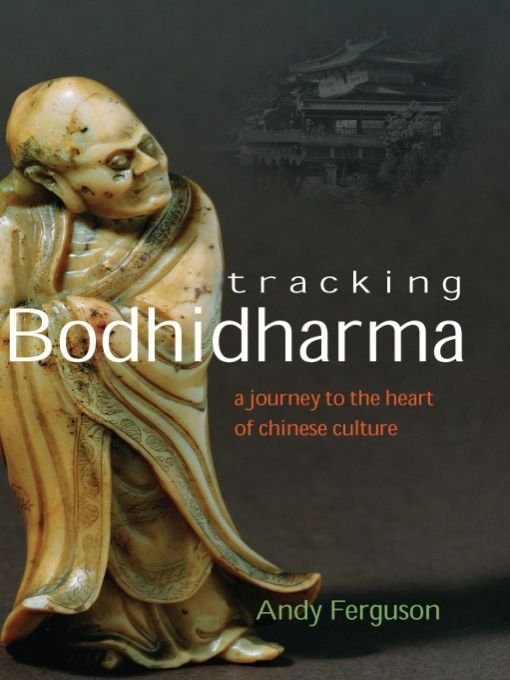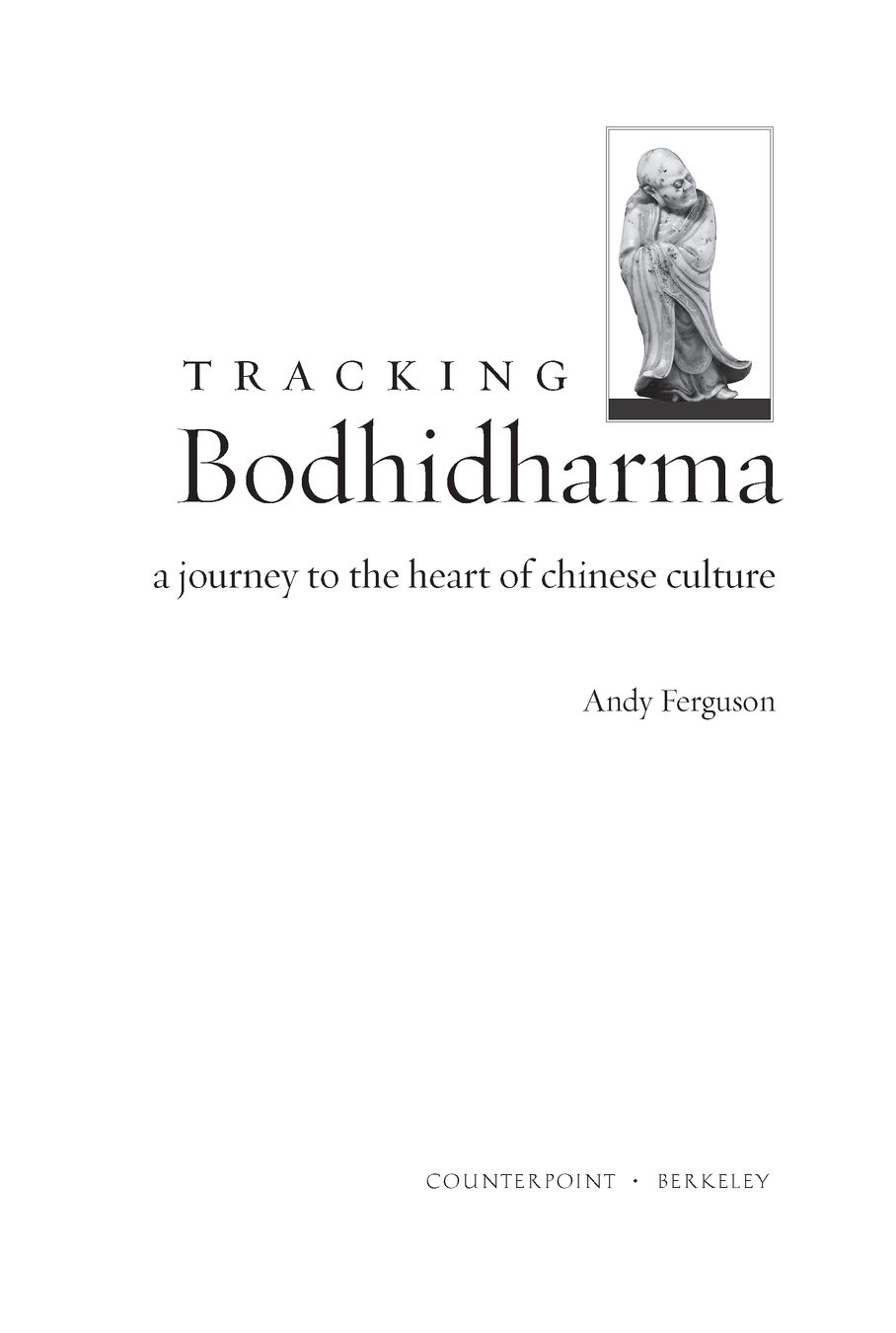Tracking Bodhidharma
Read Tracking Bodhidharma Online
Authors: Andy Ferguson



Table of Contents
Â
Â
Â
Â
Â
Â
Â
Â
Â
Â
Â
Â
Â
Â
Â
Â
Â
Â
Â
Â
Â
Â
Â
Â
Â
Â
Â
Â
Â
Â
Â
Â
Â
Â
Â
Â
Â
Â
Â
Â
Â
Â
Â
Â
Â
Â
Â
Â
Â
Â
Â
Â
Â
Introduction
THIS BOOK TRAVELS a path at the heart of Chinese culture. It follows the tracks left by Bodhidharma, a fifth-century Indian monk and important religious figure remembered as the founder of Zen Buddhism. I trace his path in China to unearth forgotten stories that shaped a civilization and reveal the roots of the religion that dominated East Asia for fifteen centuries.
This is also a personal journey, for it explores the origins and significance of Zen, a tradition I have practiced and studied for several decades.
The trail also leads into some little-known corners of Chinese history, places in the shadows of East Asia that continue to influence the region's development.
Bodhidharma, an Indian Buddhist missionary, traveled from South India to China sometime around the year 500 CE. Although his Zen religion spread relatively quickly from China to Korea and Vietnam, it was another seven hundred years before Zen finally took root in Japan, the country Westerners most frequently associate with the religion.
While Bodhidharma's teachings are known in the West as
Zen
, a Japanese word, the term is equivalent to the modern Chinese word
Chan
. This book uses the word
Zen
because it is familiar to Western audiences. Bodhidharma was the “First Ancestor” or “First Patriarch” of the Zen (Chan) sect in China.
Zen
, a Japanese word, the term is equivalent to the modern Chinese word
Chan
. This book uses the word
Zen
because it is familiar to Western audiences. Bodhidharma was the “First Ancestor” or “First Patriarch” of the Zen (Chan) sect in China.
Zen claims that successive generations of teachers have relayed its essential insight by “mind-to-mind” transmission. The religion's founding myth claims that this transmission started when the historical Buddha, Shakyamuni, sat before a crowd of his followers at Vulture Peak, a place in ancient India. There, says the legend, he held up a flower before
the assembly. In response to this gesture, his senior disciple Mahakasyapa smiled, whereupon the Buddha uttered the words that purportedly set in motion centuries of awakening:
the assembly. In response to this gesture, his senior disciple Mahakasyapa smiled, whereupon the Buddha uttered the words that purportedly set in motion centuries of awakening:
I have the treasury of the true Dharma Eye, the sublime mind of nirvana, whose true sign is signlessness, the sublime Dharma Gate, which without words or phrases is transmitted outside of the [standard Buddhist] teachings, and which I bestow upon [my disciple] Mahakasyapa.
The Zen tradition thus declared and originated its essential insight into the “signless” mind of nirvana, which can be interpreted as the nature of normal human (or any sentient being's) consciousness, which by nature is outside of time and space. In the story, the Buddha metaphorically refers to the field of consciousness (which is usually translated as “mind”) as the “Treasury of the True Dharma eye.”
As Zen developed in China, it claimed that Bodhidharma taught a refined summation of this essential Zen teaching. Bodhidharma purportedly said, “Not setting up words, a separate transmission outside the [scriptural] teachings, point directly at the human mind, observe its nature and become Buddha.” (

 )
)

 )
)The Zen tradition that coalesced from this perspective held sway as China's dominant and orthodox religion for the next fifteen hundred years. The cultural impact of Zen on East Asia can hardly be understated. This impact is perhaps best known as underlying the aesthetics of much East Asian art and literature, where landscape paintings, poetry, and other arts often reveal Zen's spare perspective.
In China, Bodhidharma taught his Zen to a Chinese disciple named Huike (pronounced
Hway-ka
). This “Second Ancestor” is credited to have transmitted Bodhidharma's teachings to others in that country. Some records indicate that China's religious and political establishment initially rejected Bodhidharma's Zen movement, persecuting Bodhidharma and Huike as heretics. Accounts claim that certain religious rivals poisoned Bodhidharma and that others denounced his disciple Huike to the authorities. Those authorities reportedly executed Huike, then cast his corpse into a river.
Hway-ka
). This “Second Ancestor” is credited to have transmitted Bodhidharma's teachings to others in that country. Some records indicate that China's religious and political establishment initially rejected Bodhidharma's Zen movement, persecuting Bodhidharma and Huike as heretics. Accounts claim that certain religious rivals poisoned Bodhidharma and that others denounced his disciple Huike to the authorities. Those authorities reportedly executed Huike, then cast his corpse into a river.
Trouble with high authorities notwithstanding, Bodhidharma and his movement had wide impact even during his lifetime. A reliable record indicates that the sage traveled widely, and that his followers were “like a city.” Having a large following and operating outside the political and religious establishment is often, of course, highly dangerous, so accounts of Bodhidharma's persecution by religious rivals and political circles seem credible.
Bodhidharma's legendary life grew in mythical detail as time passed and his religious message gained acclaim. This book examines the traditional account of his life. It also offers a different perspective, a view removed from prevailing religious and scholarly orthodoxy about Bodhidharma held in East Asia and the West. The narrative reinterprets and pieces together evidence to support a new perspective about this critical figure's life and importance. The accounts make use of the most reliable sources and shed new light on why later generations regarded Bodhidharma as such an important religious leader.
This is not simply an academic question. The ramifications of Bodhidharma's life and what he symbolized to China are only now becoming fully clear, and they extend to events that have shaped recent East Asian history. On the macro level, unraveling Bodhidharma's story reveals the roots of a narrative still being argued and even fought over in East Asia.
Other books
Classic Christmas Stories by Frank Galgay
Atop an Underwood by Jack Kerouac
The Secret of Kolney Hatch by Stefani Milan
Capture Me by Anna Zaires, Dima Zales
Theta Waves Book 1 (Episodes 1-3) by Atkinson, Thea
Fight By The Team (Team Fear Book 2) by Cindy Skaggs
I Left My Back Door Open by April Sinclair
Dr. Heartless, a short short story by Kane, Mallory
Prescription: Murder! Volume 1: Authentic Cases From the Files of Alan Hynd by Alan Hynd, Noel Hynd, George Kaczender
The King Arthur Trilogy by Rosemary Sutcliff